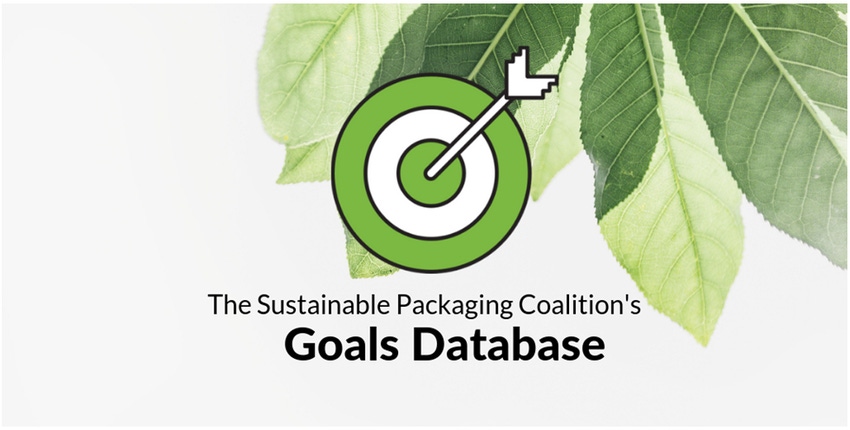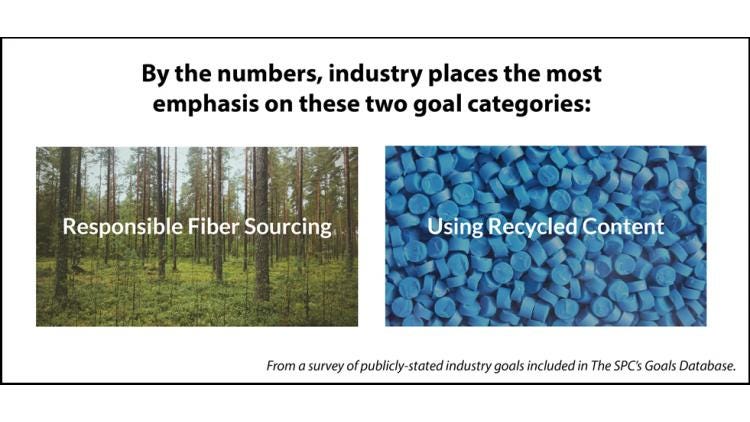New study of industry goals reveals pursuits far beyond plastics
August 6, 2019

Ask anybody what the most pressing issue is in sustainable packaging and you’re likely to receive some variation of the same answer: plastic waste. It is undeniable that the current state of affairs revolves around heightened awareness of marine plastic pollution.
In response, there is unprecedented momentum around the world created by initiatives such as the New Plastics Economy, and it’s progressed to the point where it seems that any brand owner or retailer looking to make a splash must make some kind of announcement related to plastics, be it committing to 100% recyclability by 2025, upping their usage of recycled content in plastics or taking steps to eliminate certain types of single-use plastic packaging. There is even worry from some that industry has become too single-mindedly focused on recycling and other circular economy-oriented pursuits, with an argument that tunnel-visioned strategies can create blind spots for other important issues.
Yet a closer look at industry goals and commitments, though, reveals a broad and diverse range of focus areas in sustainable packaging, with a few surprises for those believing plastics and recycling have taken over entirely.
Industry pursuits were recently studied and catalogued in the Sustainable Packaging Coalition’s newly-released Goals Database, a resource that is available for SPC members only. The database is a curated compendium of publicly-stated goals and commitments from nearly 100 major brand owners and retailers, containing hundreds of entries under 14 different classifications of pursuits in sustainability and packaging. Each entry is either designated as a goal, which is usually stated with a firm target date and target improvement, or a statement of support, which is a softer commitment without concrete metrics but still indicative of its importance to the company. By tallying up the number of goals and statements of support in categories like recyclability, material efficiency and bio-based material usage, an overarching view of industry priorities comes into focus.
The first major takeaway is that 75 of the brand owners and retailers studied—about 86%—have either goals or statements of support that address one or more concepts in sustainable packaging. Specific, tangible goals have been put forth by 48 of those companies, while only 12 companies studied have not made any public commitments whatsoever. According to the data, transparent acknowledgement of the importance of sustainable packaging is a widespread practice. The areas in which those acknowledgements are made, however, is truly a mixed bag.
For all the buzz around recent pledges to make 100% of packaging recyclable, only 20 companies were found to have made goals that draw a hard line on the percentage of packaging that must be recyclable by a target date. Another four have goals in recyclability with other boundaries, and another 24 companies have made soft commitments toward improving the recyclability of their packaging.
Summing these up, a grand total of 48 companies—about 55%—have made some type of public commitment to improving packaging recyclability. Relative to other categories of sustainable packaging pursuits, that’s a lot—more companies have made concrete goals around recyclability than they have in six other classifications of sustainable packaging improvements, and the combined number of companies with either goals or statements of support for recyclable packaging is the second most of any sustainable packaging classification included in the database.
But not the most.
The most prevalent types of sustainable packaging commitments made, it turns out, don’t address recycling or recovery at all—they address responsible sourcing.
By the numbers, industry places the most emphasis on recycled-content usage and responsible fiber sourcing. More concrete goals are made around responsible fiber sourcing than any other area in sustainable packaging—34 companies, or about 39%, have specific goals—and the number of companies making either a concrete goal or a soft commitment in recycled content usage is more than any other category: 54 companies, or about 62%.
Of those commitments in recycled content usage, only three are exclusive to plastic packaging; the vast majority either encompass all packaging materials or are an extension of a company’s goals in responsible fiber sourcing, addressing paper packaging only.
And while responsible fiber sourcing and recycled content usage are showing momentum, there are many other areas with significant activity. Commitments to reduce packaging are almost exactly as prevalent as recyclability commitments, and goals around eliminating unfavorable substances from packaging are common as well.

Of the 640 entries in the database, commitments to more sustainable packaging only account for about half. The other half are broader commitments to sustainability made on a corporate level, addressing greenhouse gas emissions, energy reduction, water reduction, operational waste reduction and renewable energy usage. When these types of goals are accounted for, they greatly exceed the number of sustainable packaging goals.
For instance, nearly every major retailer and brand owner was found to have made a public commitment to reducing greenhouse gas emissions. These types of goals are important, because packaging improvements can contribute to reductions in greenhouse gas emissions, water, waste and energy, but it is important to note that packaging is seldom mentioned when these goals are stated. Less than five companies specifically mention packaging when stating their commitments in these impact categories.
It’s unclear if packaging enters corporate conversations around impact-oriented goals, but it’s clear that the concepts of responsible sourcing, design optimization and recovery resonate the most when leading companies set out to make improvements in sustainable packaging.
Zooming back out, we can see that industry has indeed placed significant emphasis on achieving circular economy principles for plastic packaging. But perhaps the buzz around those pledges has created a misperception of an exclusive focus.
Clearly, sustainable packaging is alive and well on multiple fronts, for a number of different materials and many important focus areas. It’s an absolute certainty that plastics and recycling will continue to dominate the industry news, but quietly, companies are continuing to aim at improvements in many other areas of sustainable packaging. And for the first time, the data exists to prove it.

Adam Gendell is the associate director of GreenBlue’s flagship project, the Sustainable Packaging Coalition, a membership-based industry collaborative led by an independent non-profit that believes in the power of industry to make packaging more sustainable. Access to the Goals Database is available exclusively to SPC members.
********************************************************************************
EastPack 2019 (June 11-13) is the region's premier packaging event connecting professionals from companies like PepsiCo, Pepperidge Farms and Mars with suppliers offering the latest packaging technologies, including a range of automation solutions, from semi-automatic equipment to sophisticated "smart" systems. Register to attend today!
About the Author(s)
You May Also Like




